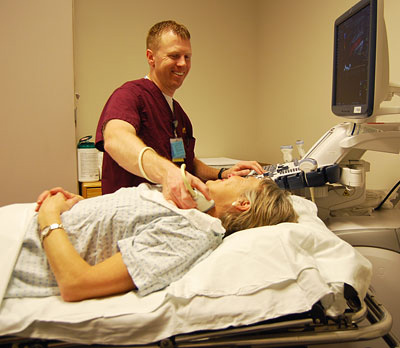Comfort
An ultrasound exam is not a terribly uncomfortable exam. However, in order to provide a high quality diagnostic exam, and gather the best possible information to help confirm whether there is a problem with the circulation, exams may require the technologist to use a moderate amount of pressure through some parts of the test. The technologist is responsible for explaining what they will be doing during each specific exam, express whether any discomfort might be expected during the exam, and to be attentive to every patients needs if the individual is unable to tolerate any part of the study. The information being gathered is potentially critical to providing accurate exam results, so we always encourage patients to work with us as much as possible while we go through the study.
We will make sure you are as comfortable as possible for your exam.
What does a Vascular Lab exam look for?
In the Vascular Lab, ultrasound is used to specifically look for circulation (blood flow) problems throughout the body. Below you will find information about what blood vessels and what parts of the body we evaluate, as well as what kind of problems we might be looking for. The specific type of testing ordered by a doctor is based on what type of symptoms a patient might be describing.
- What types of blood vessels are evaluated in the Vascular Lab?
- Arteries – This is the system of blood vessels that take blood away from the heart and deliver it throughout the body. Oxygen and nutrients are vital to all the organs and tissue throughout our body. Problems with circulation in the arterial system can prevent organs, body parts, and tissue from functioning properly and/or repairing itself after an injury.
- Veins – This is the system of blood vessels that bring blood back toward the heart and lungs. The majority of the oxygen and nutrients have been used up at this point, and the blood needs to be “recharged” so that it can be sent out again through the arterial system.
- Distinguishing new problems versus old problems
- Ultrasound can be a very useful tool in determining whether circulation problems are new or old. Blockages in the blood vessels will normally have characteristics (what the blockage looks like on the screen) that aid the reading physician in determining if a blockage is new or old. The technologist will also ask the patients to describe what symptoms (problems) they are having, how severe they are, and how long they have been going on. This information is used, along with the data gathered during testing, to assist the physicians as they try to help patients manage their medical needs.
- Acute – In medical terms, acute means “of abrupt onset”. Many symptoms of vascular problems can come on suddenly. Some symptoms are minor, some are severe, and some can be life changing or life threatening. Acute problems can occur in either the arterial system or the venous system, and are often considered High Priority exams in the vascular lab because timely treatment or additional testing can be critical to patient care.
- Chronic – In medical terms, chronic means “lasting a long time”. Like acute problems, chronic problems can also be found in either the arterial or venous system. A number of circulation problems can take weeks, months, years, or even decades before causing significant enough symptoms to lead someone to seek medical attention.
- Ultrasound can be a very useful tool in determining whether circulation problems are new or old. Blockages in the blood vessels will normally have characteristics (what the blockage looks like on the screen) that aid the reading physician in determining if a blockage is new or old. The technologist will also ask the patients to describe what symptoms (problems) they are having, how severe they are, and how long they have been going on. This information is used, along with the data gathered during testing, to assist the physicians as they try to help patients manage their medical needs.
What parts of the body can be evaluated in the Vascular Lab?
The Vascular lab evaluates blood vessels, arteries and veins, in the neck, arms, abdomen, and legs. Many of the exams involve imaging of specific blood vessels with duplex ultrasound. Some exams are performed without imaging the blood vessels. These studies, physiologic exams, rely on non-imaging techniques such as comparison of pressure measurements at multiple locations. Physiologic testing can offer information about circulation through very small vessels such as those in the fingers or toes.

